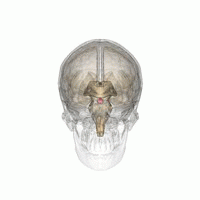| Hyperpituitarism | |
|---|---|
 | |
| Pituitary gland | |
| Specialty | Endocrinology |
| Symptoms | Hirsutism[1] |
| Causes | From a pituitary microadenoma.[2] |
| Diagnostic method | MRI[2] |
| Treatment | Dopamine agonists [2] |
Hyperpituitarism is a condition due to the primary hypersecretion of pituitary hormones;[3][medical citation needed] it typically results from a pituitary adenoma. In children with hyperpituitarism, disruption of growth regulation is rare, either because of hormone hypersecretion or because of manifestations caused by local compression of the adenoma.[2]
YouTube Encyclopedic
-
1/5Views:8 085498 912109 9471 1863 666
-
Hyperpituitarism 1
-
The hypothalamus and pituitary gland | Endocrine system physiology | NCLEX-RN | Khan Academy
-
How Does Pituitary Gland Work? Hormones of Hypophysis Functions & Disorders Animation -TSH FSH Video
-
Hyperpituitarism 4 Post Op.MOV
-
Endocrine disorders
Transcription
Symptoms and signs
Symptoms caused by hormone excess and associated mass effects include:
- Acromegaly
- Cushing's disease
- Hirsutism[1]
- Visual field loss or double vision[4]
- Excessive sweating[4]
- Decreased libido[1]
- Lethargy[5]
- Headache[5]
- Male lactation
- Muscle weakness[4]
- Bruisability[1]
Cause
The cause of hyperpituitarism in most cases is due to pituitary adenomas. They usually come from the anterior lobe, are functional and secrete the hormone, GH and prolactin.[6]
Mechanism

Evidence indicates that the mechanism of hyperpituitarism can originate from genetic disruption causing pituitary tumorigenesis, most pituitary adenomas are monoclonal, which in turn indicates their origin from an event in a single cell.[2] There are three hormones that are oversecreted resulting in the pituitary adenoma: prolactin, adrenocorticotropic hormone (ACTH), and growth hormone (GH).[medical citation needed]
Excess prolactin may result in a prolactinoma[7] Excess GH results in gigantism, the severity of gigantism depends on whether the epiphyseal plate is open.[8] The four most common types of hyperpituitarism are caused by 4 types of pituitary adenoma, as follows: prolactinoma, corticotropinoma (Cushing's disease), somatotropinoma (gigantism), and thyrotropinoma .[9]
Diagnosis
For the diagnosis of hyperpituitarism it depends on the cell type(s) affected, clinical manifestations of hormone excess may include, gigantism or acromegaly, which can be identified by clinical and radiographic results.[10] Cushing's disease diagnosis is done with a physical examination, laboratory tests and X rays of the pituitary glands (to locate tumors)[11] For prolactinoma, diagnosis comes in the form of the measurement of serum prolactin levels and x-ray of pituitary gland.[12]
Treatment

Treatment (for hyperpituitarism) in the case of prolactinoma consists of long-term medical management. Dopamine agonists are strong suppressors of PRL secretion and establish normal gonadal function. It also inhibits tumor cell replication (in some cases causes tumor shrinkage)[13] Treatment for gigantism begins with establishing target goals for IGF-1, transsphenoidal surgery (somatostatin receptor ligands- preoperatively) and postoperative imaging assessment.[14] For Cushing's disease there is surgery to extract the tumor; after surgery, the gland may slowly start to work again, though not always.[15]
See also
References
- ^ a b c d Hales, Robert E. (2007). The American Psychiatric Publishing textbook of neuropsychiatry and behavioral neurosciences (5th ed.). Washington, DC: American Psychiatric Pub. p. 815. ISBN 978-1-58562-239-9. Retrieved 26 August 2015.
- ^ a b c d e Hyperpituitarism at eMedicine
- ^ "Hyperpituitarism". Freedictionary.com. Farlex. 2015. Retrieved 28 August 2015.
- ^ a b c Wendy (2013). Medical-surgical nursing : an integrated approach (3rd ed.). Clifton Park, NY: Delmar Cengage Learning. p. 595. ISBN 978-1-4354-8802-1. Retrieved 26 August 2015.
- ^ a b "Prolactinoma". MedlinePlus. NIH. Retrieved 26 August 2015.
- ^ Kumar, Vinay; Abbas, Abul K.; Fausto, Nelson; Aster, Jon C. (2014-08-27). Robbins and Cotran Pathologic Basis of Disease, Professional Edition: Expert Consult - Online. Elsevier Health Sciences. ISBN 9780323296397.
- ^ "Prolactinoma". NIH. 2014. Retrieved 26 August 2015.
- ^ Gigantism and Acromegaly at eMedicine
- ^ Aguirre, Alfredo (2014). Cellular Endocrinology in Health and Disease. Elsevier. p. 24. ISBN 978-0-12-408134-5.
- ^ "Acromegaly". NIH. National Institute of Diabetes and Digestive, Kidney Disease. 2014. Retrieved 28 August 2015.
- ^ "Cushing's Syndrome". www.niddk.nih.gov. Retrieved 2015-08-25.
- ^ Laws, Edward; Ezzat, Shereen; Asa, Sylvia; Rio, Linda (2013-02-21). Pituitary Disorders: Diagnosis and Management. John Wiley & Sons. ISBN 9781118559376.
- ^ Hyperpituitarism~treatment at eMedicine
- ^ "National Guideline Clearinghouse | Acromegaly: an Endocrine Society clinical practice guideline". www.guideline.gov. Archived from the original on 2015-09-07. Retrieved 2015-08-25.
- ^ MedlinePlus Encyclopedia: Cushing disease
Further reading
- Handbook of Medical-surgical Nursing. Lippincott Williams & Wilkins. 2006-01-01. ISBN 9781582554457.
- Atreja, Gaurav; Jain, Nitul; Atreja, ShikhaHanda; Sukhija, Urvashi (2012). "Oral manifestations in growth hormone disorders". Indian Journal of Endocrinology and Metabolism. 16 (3): 381–3. doi:10.4103/2230-8210.95678. PMC 3354844. PMID 22629503.
- Illustrated Manual of Nursing Practice. Lippincott Williams & Wilkins. 2002-01-01. ISBN 9781582550824.
